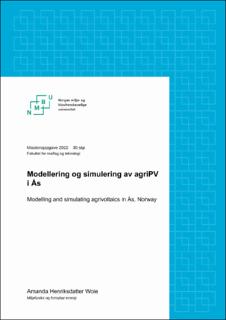| dc.contributor.advisor | Espen Olsen | |
| dc.contributor.advisor | Ingunn Burud | |
| dc.contributor.author | Woie, Amanda Henriksdatter | |
| dc.date.accessioned | 2023-05-04T16:27:55Z | |
| dc.date.available | 2023-05-04T16:27:55Z | |
| dc.date.issued | 2022 | |
| dc.identifier | no.nmbu:wiseflow:6726813:52494922 | |
| dc.identifier.uri | https://hdl.handle.net/11250/3066256 | |
| dc.description.abstract | Konseptet Agriphotovoltaics, agriPV, (APV) ble første gang introdusert av Adolf Goetzberger og Armin Zastrow i 1981 [1]. Det går ut på å implementere av solcellepaneler i landbruksområder for økt utnyttelse av solen til både dyrket mark og energi. Denne teknologien kan peke på en mulig løsning for mer arealeffektiv energiproduksjon og plantevekst, i en fremtid preget av varmere klima med behov for bærekraftige
synergier som kan ivareta økt energi- og matbehov. Det pågår allerede forskning på hvordan APV kan fungere i det norske landbruket, og hvilke fordeler og ulemper løsningen bærer med seg i et kaldt nordisk klima på høye breddegrader. Det planlegges å bygge et testanlegg på NMBU i Ås, med vertikalt monterte solcellemoduler som har flatende vendt mot øst og vest. I den forbindelse, er denne oppgavens hensikt å modellere anlegget og simulere innstråling, strømproduksjon, celletemperatur,
omgivelsestemperatur og plantevekst. Dette gjøres ved hjelp av softwaren Ladybug Tools i Grasshopper og Rhinocerous som modelleringsverktøy. Målet for oppgaven er å finne optimal avstand mellom panelradene til anlegget med bakgrunn i de nevnte simuleringene. Sikkerhetsmargin med hensyn til landbruksmaskiners bredde, er tatt i betrakning gjennom bruk av et utvalg fastsatte radavstander på 4 m, 7 m, 9 m, 13 m, 28 m og 37 m. I tillegg gjennomføres optimalisering med softwaren Wallacei,
som ved hjelp av maskinlæring, beregner at 20 m radavstand vil være beste løsning. I den hensikt å unngå reduksjon av plantevekst konkluderes det fra resultatene av de enkeltvise simuleringene, at 9 m eller 13 m er optimalt ved valg av de fastsatte radavstandene. Oppgavens evaluering av modelleringsverktøyet konkluderer med at
Ladybugs komponenter, brukt i simuleringsarbeidet, gir et godt utgangspunkt for beregninger. Samtidig er det manglende funksjonalitet når det kommer til ray tracing, strålesporing, og implementering av skygge fra horisont og systemets paneler. | |
| dc.description.abstract | Agriphotovoltaics (APV) is a concept introduced by Adolf Goetzberger and Armin Zastrow in 1981 [1]. The concept is to implement solar cell panels in agricultural areas to achieve a higher exploitation of the sun to provide energy for both cropland and photovoltaics. This is a technology in development, and a possible solution for increased need for energy and adaptation for plants in a future with increased temperatures. With Norwegian latitudes and a cold nordic climate, there are currently
research activities investigating if APV is feasible for Norwegian agriculture, and what advantages or challenges it may bring. Existing plans to build a testsite for APV with vertically mounted bifacial solar panels at the Norwegian University of Life Sciences, incentivise the need to predict the systems irradiation, electricity production, cell temperature, ambient temperatures, and crop growth. Modeling and
simulations of these elements is done with the softwareLadybug Tools in Grasshopper and Rhinocerous as main modeling tools. The goal of the thesis is to find an optimal distance between the systems panel-rows. A safety-margin to cover for the width of the different acgricultural machines used in Norway, incentivise the use of selected
row distances of 4 m, 7 m, 9 m, 13 m, 28 m and 37 m when running the simulations. There is also an additional automatic optimizing done by the Wallacei software, which suggests that a row distance of 20 m is optimal for the APV-system holistically. However, there are currently law-bound restrictions in Norwegian agriculture to not build structures in cropland that can reduce the yield. To avoid reduction of crop yields, the thesis concludes from the results of the individual simulations, that a row distance of 9 m or 13 m is optimal when choosing from the pre-selected
distances mentioned. An evaluation of the modeling software used, concludes that Ladybug’s components, used in the simulations, give a good basis for predictions, but lack functionality in terms of ray tracing and use of horizon shadow as well as shadow from the panels themselves. | |
| dc.language | nob | |
| dc.publisher | Norwegian University of Life Sciences | |
| dc.title | Modellering og simulering av agriPV i Ås | |
| dc.type | Master thesis | |
